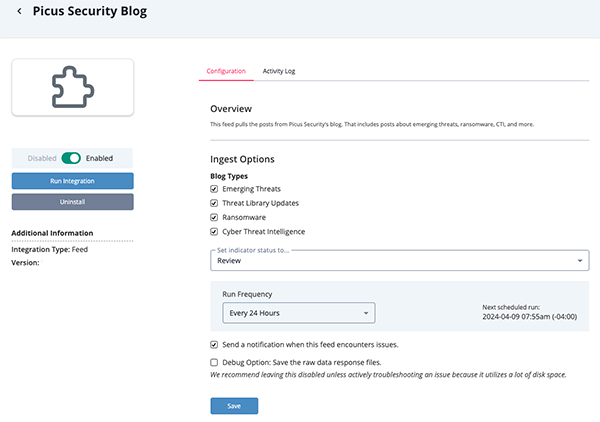Picus Security Blog CDF
The web format of this guide reflects the most current release. Guides for older iterations are available in PDF format.
Integration Details
ThreatQuotient provides the following details for this integration:
| Current Integration Version | 1.0.0 |
| Compatible with ThreatQ Versions | >= 5.25.0 |
| Support Tier | ThreatQ Supported |
Introduction
The Picus Security Blog CDF enables analysts to automatically ingest posts from the Picus Security blog, allowing analysts to stay up-to-date on news, vulnerabilities, and other threat research related articles that are published.
The integration provides the following feed:
- Picus Security Blog - fetches posts in the form of reports from the Picus Security blog.
The integration ingests Report type system objects.
Installation
Perform the following steps to install the integration:
The same steps can be used to upgrade the integration to a new version.
- Log into https://marketplace.threatq.com/.
- Locate and download the integration yaml file.
- Navigate to the integrations management page on your ThreatQ instance.
- Click on the Add New Integration button.
- Upload the integration yaml file using one of the following methods:
- Drag and drop the yaml file into the dialog box
- Select Click to Browse to locate the integration yaml file on your local machine
ThreatQ will inform you if the feed already exists on the platform and will require user confirmation before proceeding. ThreatQ will also inform you if the new version of the feed contains changes to the user configuration. The new user configurations will overwrite the existing ones for the feed and will require user confirmation before proceeding.
You will still need to configure and then enable the feed.
Configuration
ThreatQuotient does not issue API keys for third-party vendors. Contact the specific vendor to obtain API keys and other integration-related credentials.
To configure the integration:
- Navigate to your integrations management page in ThreatQ.
- Select the OSINToption from the Category dropdown (optional).
If you are installing the integration for the first time, it will be located under the Disabled tab.
- Click on the integration entry to open its details page.
- Enter the following parameter under the Configuration tab:
Parameter Description Blog Types Select the type of Blogs to ingest. Options include: - Emerging Threats
- Threat Library Updates
- Ransomware
- Cyber Threat Intelligence

- Review any additional settings, make any changes if needed, and click on Save.
- Click on the toggle switch, located above the Additional Information section, to enable it.
ThreatQ Mapping
Picus Security Blog
The Picus Security Blog feed periodically pulls threat research posts from the Picus Security Blog blog, and ingests them into ThreatQ as Report Objects.
GET https://www.picussecurity.com/resource/tag/article/
The following request returns HTML. The HTML is parsed for the title, author, date, links, etc. The blog itself is then fetched.
GET https://www.picussecurity.com/resource/blog/{{ uri }}
The mapping for this feed is based on the information parsed out of the blog's HTML content:
| Feed Data Path | ThreatQ Entity | ThreatQ Object Type or Attribute Key | Published Date | Examples | Notes |
|---|---|---|---|---|---|
| N/A | Report.Value | N/A | N/A | Phobos Ransomware Analysis, Simulation and Mitigation- CISA Alert AA24-060A |
Parsed from the HTML |
| N/A | Report.Description | N/A | N/A | N/A | Parsed from the HTML |
| N/A | Report.Attribute | External Reference | N/A | https://www.picussecurity.com/resource/ |
Parsed from HTML |
| N/A | Report.Attribute | Published At | N/A | March 01, 2024 |
Parsed from the HTML |
| N/A | Report.Tag | N/A | N/A | Ransomware |
Parsed from the HTML |
Average Feed Run
Object counts and Feed runtime are supplied as generalities only - objects returned by a provider can differ based on credential configurations and Feed runtime may vary based on system resources and load.
| Metric | Result |
|---|---|
| Run Time | 5 minutes |
| Reports | 7 |
| Report Attributes | 14 |
Known Issues / Limitations
- The feed utilizes since and until dates to make sure entries are not re-ingested if they haven't been updated.
- If you need to ingest historical blog posts, run the feed manually by setting the since date back.
- The feed will pull the last 2 pages for each blog type selected by the user in the selected time interval.
Change Log
- Version 1.0.0
- Initial release
PDF Guides
| Document | ThreatQ Version |
|---|---|
| Picus Security Blog CDF Guide v1.0.0 | 5.25.0 or Greater |